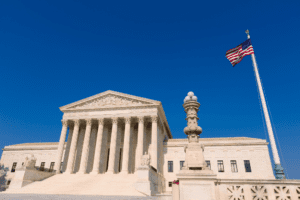 Justice Breyer continued: Without an evidentiary record, there is no reason to assume that New York courts applying this standard fail to provide license applicants with meaningful review. And there is no evidentiary record to support the Court’s assumption here. Based on the pleadings alone, we cannot know how often New York courts find the denial of a concealed-carry license to be arbitrary and capricious or on what basis. We do not even know how a court would have reviewed the licensing officer’s decisions in Koch’s and Nash’s cases because they do not appear to have sought judicial review at all. See Brief for Respondents 13; App. 122– 126.
Justice Breyer continued: Without an evidentiary record, there is no reason to assume that New York courts applying this standard fail to provide license applicants with meaningful review. And there is no evidentiary record to support the Court’s assumption here. Based on the pleadings alone, we cannot know how often New York courts find the denial of a concealed-carry license to be arbitrary and capricious or on what basis. We do not even know how a court would have reviewed the licensing officer’s decisions in Koch’s and Nash’s cases because they do not appear to have sought judicial review at all. See Brief for Respondents 13; App. 122– 126.
Second, the Court characterizes New York’s proper cause standard as substantively “demanding.” Ante, at 3. But, again, the Court has before it no evidentiary record to demonstrate how the standard has actually been applied. How “demanding” is the proper cause standard in practice? Does that answer differ from county to county? How many license applications are granted and denied each year? At the pleading stage, we do not know the answers to these and other important questions, so the Court’s characterization of New York’s law may very well be wrong. In support of its assertion that the law is “demanding,” the Court cites only to cases originating in New York City. Ibid. (citing In re Martinek, 294 App. Div. 2d 221, 743 N. Y. S. 2d 80 (2002) (New York County, i.e., Manhattan); In re Kaplan, 249 App. Div. 2d 199, 673 N. Y. S. 2d 66 (1998) (same); In re Klenosky, 75 App. Div. 2d 793, 428 N. Y. S. 2d 256 (same); In re Bernstein, 85 App. Div. 2d 574, 445 N. Y. S. 2d 716 (1981) (Bronx County)). But cases from New York City may not accurately represent how the proper cause standard is applied in other parts of the State, including in Rensselaer County where petitioners reside.
A response to the dissent is that the majority knows how the standard was applied in the two cases before it and those cases provided enough insight. The dissent also does not address how the “arbitrary and capricious” standard is very difficult to overcome on appeal.
